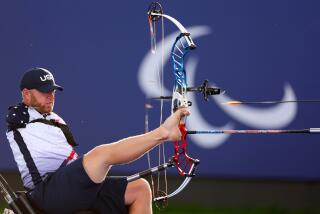Finale to 2002 Games: The Paralympics
- Share via
WEST VALLEY CITY, Utah — When closing ceremonies signal the end of the 2002 Winter Olympics, Joann Klonowski and her staff will just be warming up.
Klonowski is responsible for managing the Paralympics, which will be staged 10 days after the 2002 Winter Games turn the world’s attention to Salt Lake City. It’s her job to keep the Olympic momentum going until the world’s best disabled athletes go home.
“Because it is overshadowed by the Olympics, we have to do a great deal of grass-roots promotion ahead of time,” she said. “It’s critical during the 10 days between the Olympics and Paralympics that we promote our games.”
Last month, the Salt Lake Organizing Committee staged its first Paralympics test event, the world championship tournament for the sport of ice sledge--hockey for disabled athletes. Several dozen busloads of squealing schoolchildren packed the E-Center, the Olympic hockey venue.
The kids seemed most excited while watching themselves dance on the arena’s mammoth video board. But Team USA co-captain Kip St. Germaine of Sagamore, Mass., said the crowd offered a taste of what’s to come.
“When the Olympics come here, it will be standing room only,” he said. “People will be fighting to get tickets. That’s true of the Paralympics as well. It should be an exciting time.”
On the ice, athletes from Sweden and Norway pumped their arms to propel their 3-foot sleds. They zipped like bumper cars, chasing the puck and then trying to flip it past the goalie.
“It’s the same game,” said St. Germaine, 34, who played hockey in high school and college. “You put on the equipment. You work with teammates to put more pucks in the net than the other team does.”
Besides ice sledge, the Paralympics will include alpine and Nordic skiing, a biathlon competition and short-track sled racing.
“It’s incredible what athletes with disabilities can achieve,” Klonowski said. “When you watch an event, you start to disregard the disabilities. You see them as world-class athletes.”
St. Germaine credits ice sledge for allowing him to continue his athletic career after a construction accident left him paralyzed from the waist down almost 11 years ago.
“The biggest difference was that I could see the play developing, I couldn’t get there as fast,” he said. “But it’s full equipment and full contact.”
If Utah residents haven’t heard much about the Paralympics, that’s by design. Klonowski said most of the advertising budget will be spent during the 10 days between the Olympics and the Paralympics.
To increase ticket sales, Klonowski said organizers plan to use marketing methods similar to professional baseball teams, such as group sales or family packages.
Planning for the Paralympics has different challenges than the Olympics too. Accessibility is the biggest issue, and organizers will ensure that athletes and spectators can enter and leave venues easily.
Klonowski was vice president for the Atlanta Paralympics in 1996. “You learn some incidental things, like making sure the athlete is comfortable,” she said. “That can be as simple as making sure the buffet tables are low for wheelchairs, or making sure a bed is not too high.”
Other concerns might slip past the able-bodied: Paralympic organizers can’t sprinkle salt on sidewalks to melt ice because it irritates the paws of guide dogs for blind people.
The Salt Lake events mark the first time since the Paralympics began in 1976 that the same organizing committee will manage the Olympics and Paralympics.
“Whoever sells sponsors for one sells sponsors for both,” Klonowski said. “Also, you don’t have a lot of disagreements you might have if there were different organizing committees.”
The Paralympics also offers a second chance for spectators who can’t afford high-priced Olympic tickets.
“We’re accessible,” Klonowski said. “People who don’t have the opportunity to go to the Olympic opening ceremony can go to the Paralympic opening ceremony.”
More to Read
Go beyond the scoreboard
Get the latest on L.A.'s teams in the daily Sports Report newsletter.
You may occasionally receive promotional content from the Los Angeles Times.







